Winchester College
Winchester College is an independent boarding school for boys in the British public school tradition, situated in Winchester, Hampshire. It has existed in its present location for over 600 years. It is the oldest of the nine English public schools considered by the Clarendon Commission, seven of which were regulated by the Public Schools Act 1868.
| Winchester College | |
|---|---|
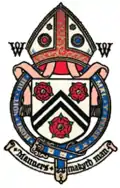 | |
| Address | |

| |
College Street , , SO23 9NA England | |
| Coordinates | 51°03′29″N 01°18′46″W |
| Information | |
| Type | Public school Independent boarding school |
| Motto | Manners makyth man |
| Religious affiliation(s) | Church of England |
| Established | 1382 |
| Founder | William of Wykeham |
| Department for Education URN | 116532 Tables |
| Warden | Richard Stagg |
| Headmaster | Timothy Hands |
| Staff | ~200 |
| Gender | Male |
| Age | 13 to 18 |
| Enrolment | ~673 |
| Houses | 11 (10 Commoner Houses plus college)
(X) College A. Chernocke House (Furley's) B. Moberly's (Toye's) C. Du Boulay's (Cook's) D. Fearon's (Kenny's) E. Morshead's (Freddie's) F. Hawkins' (Chawker's) G. Sergeant's (Phil's) H. Bramston's (Trant's) I. Turner's (Hopper's) K. Kingsgate House (Beloe's) |
| Colour(s) | Blue, brown & red |
| Publication | The Wykehamist, Quelle, The Spirit Lamp, The Trusty Servant |
| Former pupils | Old Wykehamists |
| School song | Dulce Domum |
| Website | www |
Official name
According to its 1382 charter and final statutes (1400), the school is called in Latin Collegium Sanctae Mariae prope Wintoniam, or Collegium Beatae Mariae Wintoniensis prope Winton, which translates as St Mary's College, near Winchester, or The College of the Blessed Mary of Winchester, near Winchester.[1][2]:9,45–47 It is sometimes referred to by pupils, former pupils and others as "Win: Coll:", and is more widely known as just "Winchester".
Wykehamists
Current pupils of Winchester College are known as Wykehamists, in memory of the school's founder, William of Wykeham; former pupils are known as Old Wykehamists,[3] or amongst themselves as Old Woks.[4]
History
Winchester College was founded in 1382 by William of Wykeham, Bishop of Winchester and Chancellor to both Edward III and Richard II, and the first 70 poor scholars entered the school in 1394.[5] In the early 15th century the specific requirement was that scholars come from families where the income was less than five marks sterling (£3 6s 8d) per annum; in comparison, the contemporary reasonable living for a yeoman was £5 per annum.[6] It was founded in conjunction with New College, Oxford, for which it was designed to act as a feeder:[5] the buildings of both colleges were designed by master mason William Wynford. This double foundation was the model for Eton College and King's College, Cambridge, some 50 years later.[7]
At first only a small number of pupils other than scholars were admitted; by the 15th century the school had around 100 pupils in total, nominally the 70 scholars, 16 choirboys known as "quiristers", and the rest "commoners". Demand for places for commoners was high, and though at first restricted, numbers gradually rose.[8] From the 1860s, ten boarding houses, each for up to sixty pupils, were added, greatly increasing the school's capacity.[9] By 2020, the number of pupils had risen to 690.[10]
College
The seventy Scholars live in the original buildings, known as College; an individual scholar is known as a "Collegeman". College is not usually referred to as a house: hence the terms 'housemaster of College' and 'College house' are not used. The schoolmaster in charge of College is now known as the Master in College, although these duties formerly belonged to the Second Master. The same title, Master in College, is also used by the housemaster of the King's Scholars at Eton. The Collegemen wear black gowns, following the founding traditions of the school. Within the school, 'College', without 'the', means both the body of scholars and their buildings; 'Winchester College' and 'the college' refer to the school as a whole. The scholars, called 'Collegemen', enjoy certain privileges compared to the Commoners, such as having open fires and being allowed to walk across Meads, the field outside School.[11]
Boarding houses
| Official Name | Informal Name | House Letter |
|---|---|---|
| Chernocke House | Furley's | A |
| Moberly's | Toye's | B |
| Du Boulay's | Cook's | C |
| Fearon's | Kenny's | D |
| Morshead's | Freddie's | E |
| Hawkins' | Chawker's | F |
| Sergeant's | Phil's | G |
| Bramston's | Trant's | H |
| Turner's | Hopper's | I |
| Kingsgate House | Beloe's | K |
Every pupil at Winchester, apart from the Scholars, lives in a boarding house, chosen or allocated when applying to Winchester. It is here that he studies, eats and sleeps. Each house is presided over by a housemaster (who takes on the role in addition to teaching duties), assisted by house tutors. Houses compete against each other in school sports. Each house has an official name, usually based on the family name of the first housemaster, which is used mainly as a postal address. Each house also has an informal name, usually based on the name or nickname of an early housemaster. Each house also has a letter, in the order of their founding, to act as an abbreviation, especially on laundry tags. A member of a house is described by the informal name of the house with "-ite" suffixed, as "a Furleyite", "a Toyeite", "a Cookite" and so on. College does not have an informal name, although the abbreviation Coll is sometimes used; its letter is X.[12]
Admission
Winchester has its own entrance examination, and does not use Common Entrance like other major public schools. Those wishing to enter a Commoner House make their arrangements with the relevant housemaster some two years before sitting the exam, usually sitting a test set by the housemaster and an interview. Those applying to College do not take the normal entrance examination but instead sit a separate, harder, exam called "Election": successful candidates may obtain, according to their performance, a scholarship, an exhibition or a Headmaster's nomination to join a Commoner House.[13] Admission to College was historically coupled to remission of fees but this has ceased;[14] instead, means-tested bursaries of from 5% to 100% of the school fee are provided according to need.[15]
Academic structure
In addition to normal lessons, all boys throughout the school are required to attend a class called Division (known as "Div") which focuses on parts of history, literature, and politics that do not lead to external examinations; its purpose is to ensure a broad education that does not focus solely on examinations.[16]
From year 9, pupils study for at least nine GCSE and IGCSEs. Every pupil studies English, mathematics, Latin, French or German, and at least two sciences at this level, as well as "Div". Pupils then study three A-levels, "Div", and an Extended Project Qualification.[17]
Results
At Pre-U, 49.3% of grades achieved were D1 or D2, and 86.4% of grades achieved were D1-M1 in 2018. 68.4% of GCSEs were graded A* or equivalent (9 or 8), in comparison to 62.5% in 2017; 92.1% were graded A*/A or equivalent (9,8 or 7), in comparison to 90.5% in 2017. There were 36 Oxbridge offers; 18 at Oxford and 18 at Cambridge.[18]
Buildings
Chapel
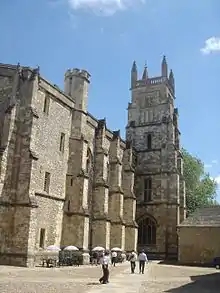 Chapel
Chapel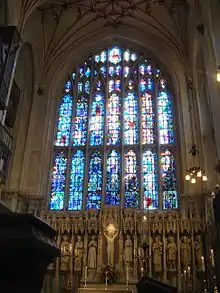 East window
East window Chapel ceiling
Chapel ceiling North side (before restoration)
North side (before restoration) North side (after restoration)
North side (after restoration)
Situated on the south side of Chamber Court, the chapel is part of the original college buildings; it retains its original wooden fan-vaulted ceiling, designed by Hugh Herland, carpenter to King Richard II.[19] A striking feature of the chapel is its stained glass. The East window depicts the stem of Jesse. Down the chapel's north and south sides is a collection of saints. Little of the original medieval glass, designed by Thomas Glazier, survives. A firm of glaziers in Shrewsbury, Betton and Evans, was tasked with cleaning the glass in the 1820s. At that time there was no known process for cleaning the badly deteriorated glass and so it was copied, while most of the original glass was scattered or destroyed. Some pieces have been recovered. The art historian and Old Wykehamist, Kenneth Clark, bought back the Tree of Jesse section of the east window, now housed in Thurburn's Chantry. Further figures have been returned; they form the east window of Fromond's Chantry.[19] The Chapel Choir sings regular services in the chapel, as well as other venues. This consists of sixteen Quiristers (who attend The Pilgrims' School) and a similar number of senior boys and a few dons (masters).[19]
War Cloister

Situated to the west of Meads, this cloister serves as a memorial to the Wykehamist dead of the two World Wars. It was designed by Herbert Baker and dedicated in 1924. It is a listed building.[20] A bronze bust of Old Boy Air Chief Marshal Lord Dowding sits on the west side of the cloister.[20]
The College's South Africa Gate on Kingsgate Street commemorates the Wykehamist dead of the 1899–1902 Boer War. It leads to the War Cloister.[21] Another older war memorial in the school is the entry chamber to Chapel, known as "Crimea" after the Crimean War of 1853–56, and bearing the names of Wykehamists who died at the siege of Sebastopol.[22]
Traditions
Notions
A notion is a manner or tradition peculiar to Winchester College. The word notion is also used for words and phrases used only in the school. An example is "toytime", meaning prep or homework, from the "toys" or individual cubicles that formerly served as pupils' workspace in the communal chamber or "mugging hall", from "mug" meaning to work.[23]
Sport
Winchester College has its own game, Winchester College football (also known as "Win: Co: Fo:" or "Winkies"), played only at Winchester.[24] It is played in the spring term with a competition between the school's houses; it is largely managed by the boys.[25]
A distinctive Winchester version of Fives resembles Rugby Fives but with a buttress on the court. The buttress enables a skilful player to cause the ball to ricochet in an unexpected direction.[26]
The school has an active rowing club called the Winchester College Boat Club which is based on the River Itchen. The club is affiliated to British Rowing (boat code WIN)[27] and was twice winner of the Princess Elizabeth Challenge Cup in 1949 and 1954, at the Henley Royal Regatta.[28]
Combined Cadet Force
Pupils of the school in their second year are currently required to serve in the college's Combined Cadet Force.[29]
The organisation was founded in 1860 as "The Winchester College Rifle Volunteer Corps" by various boys in their top year as a result of the perceived threat of Napoleon III after the Orsini plot, and remained entirely autonomous until it was taken over by the Second Master in 1868. It was enrolled as a Cadet Corps in the 1st Hants Volunteer Battalion. In 1908, the Officer Training Corps was established, and by 1914, through the request of the War Office that Senior Cadets be given appropriate training for the war effort, almost every student became involved in the Corps, though it was never explicitly compulsory. In the Second World War, it was renamed as "The Junior Training Corps", though its function was still to prepare boys for Officer responsibilities. Montgomery remarked on inspecting the Corps in 1946 that there was "latent leadership in all ranks". In 1948, the "Junior Training Corps" became known as the "Combined Cadet Force" (CCF) which incorporated RAF and RN sections. In 1963, "Alternative Service Activities" were introduced for boys who did not want to join the CCF. Pupils were made eligible to opt out of the CCF at the end of their second year after starting at the beginning of the year: this is still the school's policy.[30] In 2010, Winchester's Combined Cadet Force received the Queen's Colours, a regimental decoration.[31]
School song Domum
The school song is "Domum, Domum, Dulce Domum", sung at the break-up of the school for the summer holidays. Its origin is unknown; it was described as "an old tradition" in the 1773 History and Antiquities of Winchester.[32] The traditional tune was composed by John Reading.[33][34] A new tune, by Malcolm Archer, was officially adopted by the school in about 2007.[35]
According to legend, the text was written in the 17th century by a pupil who was confined for misconduct during the Whitsun holidays.[36] (In one account, he was tied to a pillar.) It is said that he carved the words on the bark of a tree, which was thereafter called "Domum Tree", and cast himself into Logie (the river running through the school grounds).[32][37] There is still a "Domum Cottage" in that area. The author of the text apparently wrongly treated domum as a neuter noun.[38]
A "Domum Dinner" is held at the end of the summer term for leavers. It was formerly restricted to those former scholars of Winchester who were also scholars of New College, and distinguished guests. Until the reforms of the 19th century, there were three successive Election Dinners held during Election Week, culminating in a Domum Ball. Originally these festivities occurred around Whitsun, as suggested by references in the song to early summer such as "See the year, the meadow, smiling" and "Now the swallow seeks her dwelling".[33]
The Trusty Servant
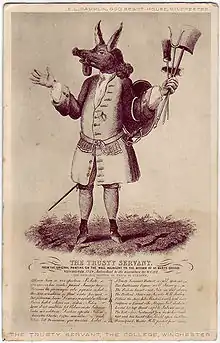
A 1579 wall-painting of The Trusty Servant by the poet John Hoskins hangs outside the college kitchen. It depicts a mythical creature with the body of a man, the head of a pig, its snout closed with a padlock (to keep secrets), the ears of an ass (to hear his master calling), the feet of a stag (for swiftness), and holding working tools in his left hand.[39] It is accompanied by allegorical verses on the virtues that pupils of the college were supposed to have. The college arms are shown in the background.[40][41]
"The Trusty Servant" is also the name of a magazine published for Old Wykehamists.[42]
Winchester quotations
Manners makyth man
– William of Wykeham Motto of Winchester College and New College, Oxford
Broad of Church and broad of mind,
Broad before and broad behind,
A keen ecclesiologist,
A rather dirty Wykehamist.
– John Betjeman "The Wykehamist"
Leader in London's preservation lists
And least Wykehamical of Wykehamists{:}
Clan chief of Paddington's distinguished set,
Pray go on living to a hundred yet!
– John Betjeman "For Patrick" (about Patrick Balfour, 3rd Baron Kinross)
You can always tell a Wykehamist, but you can never tell him much
– Anon.
These Wykehamists have the kind of mind that likes to relax by composing Alcaics on the moving parts of their toy trains.
– Evelyn Waugh
Would you doubt the word of a Wykehamist?
– Edward Grey, 1st Viscount Grey of Fallodon
O, Eternal God, the Life and the Resurrection of all them that believe in Thee, always to be praised as well for the Dead as for those that be Alive, we give Thee most hearty Thanks for our Founder, William of Wykeham; and all other our Benefactors, by whose Benefits we are here brought up to Godliness and the studies of good Learning; beseeching Thee that we, well using all these Thy Blessings to the Praise and Honour of Thy Holy Name, may at length be brought to the Immortal Glory of the Resurrection, through Jesus Christ our Lord. Amen.
– "Thanksgiving for the Founder" as at present used on commemoration days
Headmasters
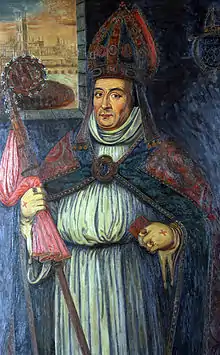
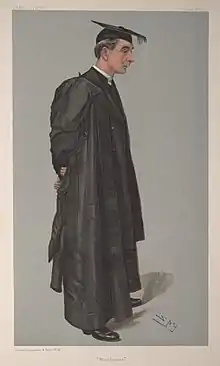
- 1373 Richard Herton
- 1388 John Melton
- 1394 Thomas Romsey
- 1407 John Pole
- 1414 Thomas Romsey
- 1418 Richard Darcy
- 1424 Thomas Alwyn
- 1430 William Waynflete
- 1441 Thomas Alwyn
- 1444 William Yve
- 1454 John Barnard
- 1459 John Grene
- 1465 Clement Smyth
- 1467 Richard Dene
- 1484 John Rede
- 1490 Robert Festham
- 1495 William Horman
- 1501 John Farlyngton
- 1507 Edward More
- 1515 Thomas Erlisman
- 1525 John Twychener
- 1531 Richard Twychener
- 1535 John White
- 1542 Thomas Bayly
- 1547 William Everard
- 1553 Thomas Hyde
- 1561 Christopher Johnson
- 1572 Thomas Bilson
- 1579 Hugh Lloyd
- 1588 John Harmar
- 1596 Benjamin Heyden
- 1602 Nicholas Love
- 1613 Hugh Robinson
- 1627 Edward Stanley
- 1642 John Pottinger
- 1653 William Burt
- 1658 Henry Beeston
- 1679 William Harris
- 1700 Thomas Cheyney
- 1724 John Burton
- 1766 Joseph Warton
- 1793 William Stanley Goddard
- 1810 Henry Dyson Gabell
- 1824 David Williams
- 1836 George Moberly
- 1867 George Ridding
- 1884 William Andrewes Fearon
- 1901 Hubert Murray Burge
- 1911 Montague John Rendall
- 1924 Alwyn Terrell Petre Williams
- 1934 Spencer Leeson
- 1946 Walter Fraser Oakeshott
- 1954 Henry Desmond Pritchard Lee
- 1968 John Leonard Thorn
- 1985 James Paley Sabben-Clare
- 2000 Edward Nicholas Tate
- 2003 Thomas Richard Cookson
- 2005 Ralph Douglas Townsend
- 2016 Timothy Roderick Hands[43]
Former pupils
Controversy
Bash camps
The college knew in 1982 of allegations of sadomasochistic abuse of boys and young men attending summer camps run by the Iwerne Trust in the 1970s, "to ensure that future members of the establishment were committed Christians" These were known as “Bash camps” after the nickname of their founder, E. J. H. Nash. Neither the college nor the Trust reported these bare-buttocks beatings to the police.[44] The perpetrator, John Smyth QC, now deceased was warned off and moved to Zimbabwe and then South Africa where abuse continued. Hampshire police are investigating and the college is cooperating.[45]
Price-fixing
In 2005, Winchester College was one of fifty of the country's leading independent schools which were found guilty of running an unlawful price-fixing cartel by the Office of Fair Trading ("OFT").[46] All of the schools involved agreed to make penalty payments totalling three million pounds into a trust designed to benefit pupils who attended the schools during the period in which fee information was shared.[47] The OFT offered both Winchester College and Eton a fifty percent reduction in their penalties in return for their full cooperation with the investigation.[48] However, Jean Scott, the head of the Independent Schools Council, said that independent schools had always been exempt from anti-cartel rules applied to business, were following a long-established procedure in sharing the information with each other, and that they were unaware of the change to the law (on which they had not been consulted). She wrote to John Vickers, the OFT director-general, saying, "They are not a group of businessmen meeting behind closed doors to fix the price of their products to the disadvantage of the consumer. They are schools that have quite openly continued to follow a long-established practice because they were unaware that the law had changed."[49]
Examination fraud
In 2017 Winchester College suspended a member of the staff for providing students with information about questions on an upcoming public exam.[50] The headmaster of Winchester confirmed that the school had treated the matter "very seriously" and that no boy was responsible for the "exam irregularity". The information was widely distributed resulting in their papers being disallowed.[51][52]
Southern Railway V (‘Schools’) Class Locomotive No. 901
As with other prominent public schools, a locomotive of the Southern Railway V Class was named after Winchester College. The second of the class, No. 901 Winchester was constructed by Southern at the nearby Eastleigh Works; it entered service in 1930. It was selected by the railway's new chief mechanical engineer Oliver Bulleid for rebuilding with a Lemaître multiple-jet blastpipe and wide-diameter chimney from 1939 onwards. Upon passing into British Railways ownership in 1948, it was renumbered 30901. It was withdrawn from service in 1962.[53]
See also
References
- Hebron, Malcolm (30 January 2019). "The statutes of Winchester College, 1400". In Foster, Richard (ed.). 50 Treasures from Winchester College. SCALA. p. 55. ISBN 9781785512209.
- Foster, Richard, ed. (2019). 50 Treasures from Winchester College. SCALA. ISBN 9781785512209.
- Spicer, Paul (2014). Sir George Dyson: His Life and Music. Boydell & Brewer. p. 139. ISBN 978-1-84383-903-3.
- Adams, Michael (2012). Slang: The People's Poetry. Oxford University Press. p. 38. ISBN 978-0-19-998653-8.
- "How has history shaped our school?". Winchester College. Retrieved 16 February 2020.
- Harwood, Winifred A. (2004). "The Household of Winchester College in the later Middle Ages 1400-1560" (PDF). Proceedings of the Hampshire Field Club Archaeological Society. 59: 163–179. Retrieved 4 September 2018.
- Clutton-Brock, A. (1900). Eton. George Bell and Sons. pp. 3–5.
- Turner, David (2014). The Old Boys : the decline and rise of the public school. Yale University Press. pp. 2–9. ISBN 978-0-300-18992-6.
- "Houses: Why is it so important to belong?". Winchester College. Retrieved 22 February 2020.
- "Winchester College". SchoolSearch.co.uk. Retrieved 22 February 2020.
- "Winchester College". The City of Winchester. 1990. Retrieved 8 October 2020.
- "Houses". Winchester College. Retrieved 8 October 2020.
- "Timeline for Entry". Winchester College. Retrieved 8 October 2020.
- Scholarships for College Archived 8 June 2010 at the Wayback Machine. Winchester College. Retrieved on 13 August 2013.
- "Bursaries". Winchester College. Retrieved 8 October 2020.
- "Div". Winchester College. Retrieved 4 October 2020.
- "Curriculum". Winchester College. Retrieved 8 October 2020.
- Retrieved 05 April 2019.
- "Chapel". Winchester College. Retrieved 4 October 2020.
- "The War Cloister, Winchester College". Historic England. Retrieved 4 October 2020.
- "Wykehamists- Boer War". Imperial War Museum. Retrieved 7 October 2020.
- "Winchester College Crimea". Imperial War Museum. Retrieved 7 October 2020.
- Lawson, W.H., Hope, J.R. and Cripps, A.H.S., Winchester College Notions, by Three Beetleites: Winchester 1901, pp. 81, 126–127
- "Arcane public school games explained: Anyone for Rugby Fives, The Field Game or Winkies?". The Independent. 29 August 2014. Retrieved 4 October 2020.
- "Sport: Winchester College Football". Winchester College. Retrieved 8 October 2020.
- "Get Active: Why Winchester Fives is better than squash". Southern Daily Echo. 19 March 2015. Retrieved 4 October 2020.
- "Club details". British Rowing.
- "Results". Friends of Rowing History. Retrieved 8 October 2020.
- Combined Cadet Force Archived 21 June 2010 at the Wayback Machine. Winchester College. Retrieved on 13 August 2013.
- "Archived copy" (PDF). Archived (PDF) from the original on 16 July 2011. Retrieved 17 June 2010.CS1 maint: archived copy as title (link)
- http://www.winchestercollege.org/winchester-college-combined-cadet-force-celebrates-150-years-of-unbroken-service
- Adams, Henry Cadwallader (1878). Wykehamica: A History of Winchester College and Commoners, from the Foundation to the Present Day. J. Parker and Company. pp. 407–.
- The British Minstrel, and Musical and Literary Miscellany: A Selection of Standard Music, Songs, Duets, Glees, Choruses, Etc. and Articles in Musical and General Literature. W. Hamilton. 1843. pp. 131–.
- William of Wykeham and his Colleges. D. Nutt. 1852. p. i.
- "Winchester College - The School Song: Domum". www.winchestercollege.org. Archived from the original on 30 September 2017. Retrieved 2 May 2018.
- The Gentleman's Magazine, 1796, vol. 66, pp. 208–210.
- Charles Dickens, All the Year Round 29 June 1872 p 160.
- Robert Townsend Warner, Winchester (1900) p 168.
- Skull, Joseph (30 January 2019). "Dr Collegio Wintoniensi, 1640s". In Foster, Richard (ed.). 50 Treasures from Winchester College. SCALA. p. 86. ISBN 9781785512209.
- Burnett, Mark Thornton (2002). Constructing "monsters" in Shakespearean drama and early modern culture. Macmillan. p. 139.
- "The Trusty Servant". British Museum. Missing or empty
|url=(help) - "Publications". Winchester College. Retrieved 4 October 2020.
- "Winchester College - Meet the Headmaster". www.winchestercollege.org. Archived from the original on 3 October 2017. Retrieved 2 May 2018.
- Laville, Sandra; Sherwood, Harriet (2 February 2017). "Public school defends role in alleged cover up of abuse at Christian camps". The Guardian. Retrieved 13 August 2019.
- Sherwood, Harriet (13 August 2019). "Welby in spotlight over sadistic abuse claims at Christian camps". The Guardian. Retrieved 13 August 2019.
- [The Schools Competition Act Settlement Trust "Archived copy". Archived from the original on 20 March 2012. Retrieved 15 February 2011.CS1 maint: archived copy as title (link)]
- "The Office of Fair Trading: OFT names further trustees as part of the independent schools settlement". oft.gov.uk. Archived from the original on 10 June 2008. Retrieved 2 May 2018.
- "Archived copy". Archived from the original on 7 October 2008. Retrieved 26 August 2015.CS1 maint: archived copy as title (link) The Times Online
- "Private schools send papers to fee-fixing inquiry". The Daily Telegraph. London. 3 January 2004. Archived from the original on 25 June 2013. Retrieved 15 March 2010.
- Adams, Callum (28 August 2017). "Exam fraud scandal at Winchester College". The Times. Retrieved 2 May 2018.
- Adams, Richard (30 August 2017). "Eton pupils' marks disallowed over second exam paper leak". The Guardian. Archived from the original on 30 August 2017. Retrieved 30 August 2017.
- Miranda Green (1 September 2017), The rigged crapshoot of top exam grades, The Financial Times, archived from the original on 10 October 2017
- Russell, J. H. A Pictorial History of Southern Locomotives, Haynes Publishing, 1991, p. 306
Further reading
- Adams H. C., Wykehamica: A History of Winchester College: Oxford, London and Winchester 1878
- Cook, A. K., About Winchester College: London 1917
- Custance, R., (ed.), Winchester College: Sixth Centenary Essays: Oxford, 1982 ISBN 0-19-920103-X
- Dilke, Christopher, Dr Moberly's Mint-Mark: A Study of Winchester College: London 1965
- Fearon, W. A., The Passing of Old Winchester: Winchester 1924, repr. 1936
- Firth, J. D'E., Winchester College: Winchester 1961
- Kirby, T. F., Annals of Winchester College: London 1892
- Leach, Arthur F., A History of Winchester College: London 1899 (Review)
- Mansfield, Robert, School Life at Winchester College: 1866
- Rich, Recollections of the Two St. Mary Winton Colleges: 1883
- Sabben-Clare, James, Winchester College: Paul Cave Publications, 1981, ISBN 0-86146-023-5
- Stevens, Charles, Winchester Notions: The English Dialect of Winchester College: London, 1998
- Tuckwell, The Ancient Ways: Winchester Fifty Years Ago: 1893
- Walcott, Mackenzie E. C., William of Wykeham and his Colleges: 1852
- Charles Wordsworth, The College of St Mary Winton near Winchester: Oxford and London, 1848
External links
| Wikimedia Commons has media related to Winchester College. |
- Chandos, John (1985). Boys together : English public schools, 1800-1864. Oxford: Oxford University Press. p. 351. ISBN 0192818821.
- Archive Administrator (9 March 2010). "OFT issues statement of objections against 50 independent schools". The Office of Fair Trading. Retrieved 26 May 2019.